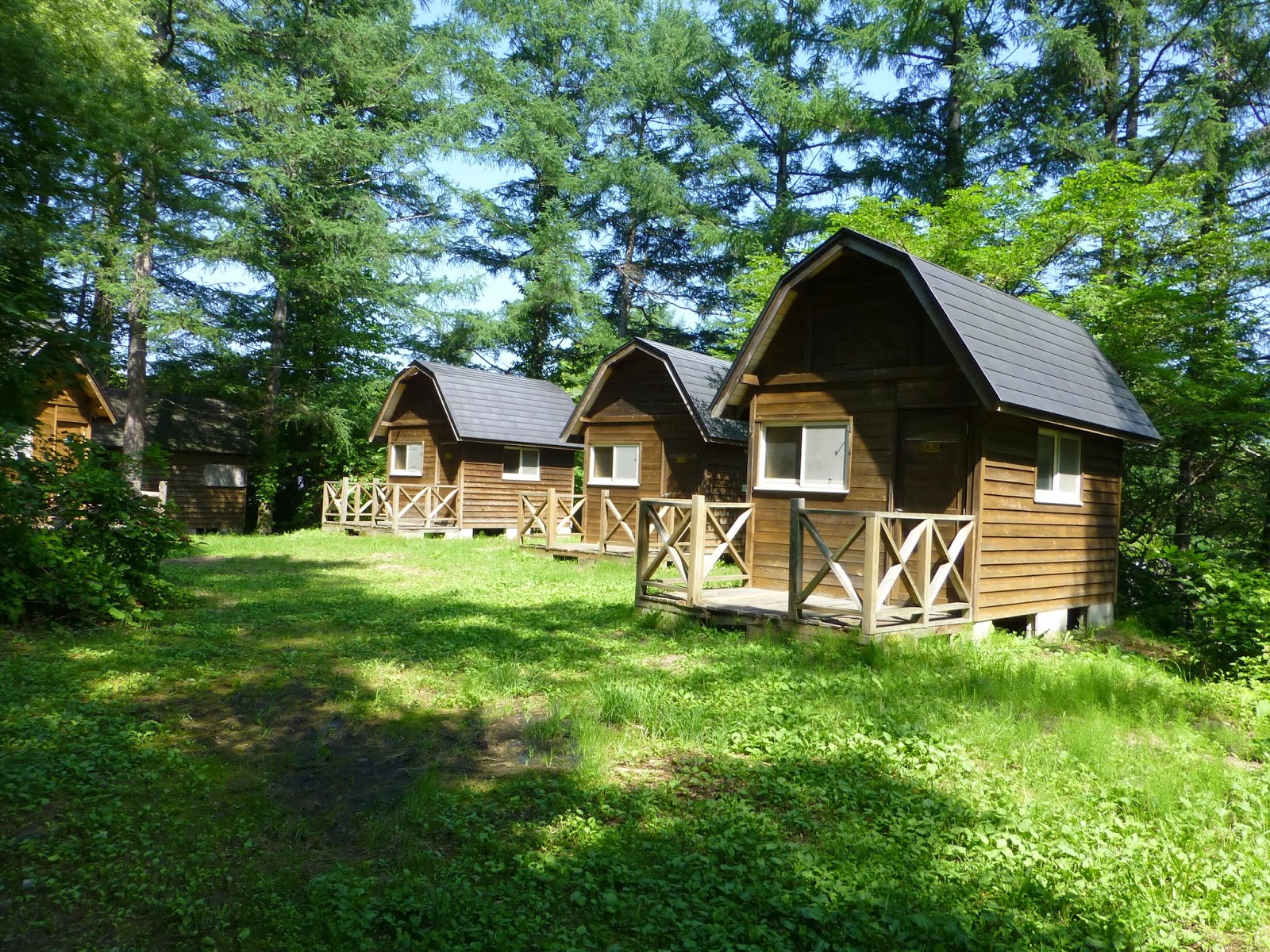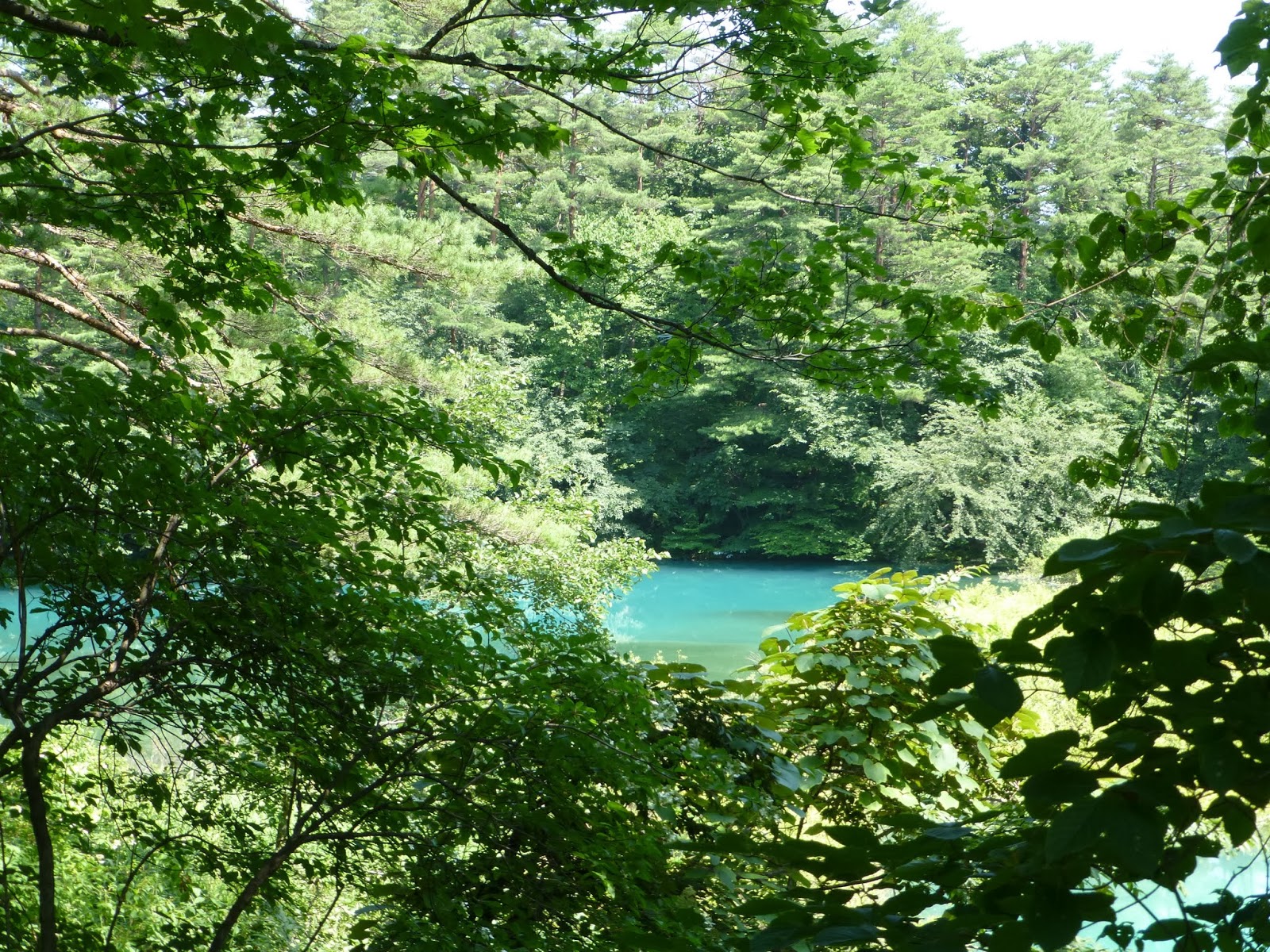I can't think of a country outside America that has as much to offer as Japan. The major cities of Tokyo, Nagoya, Osaka, and Sapporo have interesting shopping, entertainment, nightlife, and museums and other tourist attractions to explore. All of Japan is covered with castles and temples and piles of history. And Japan's location and size means there are several different climates and environments that result in enviable seasons and amazing natural locations.
The Goshikinuma Trail in Urabandai (Behind Bandai), is just north of Bandai Mountain. It is a four-kilometer generally-flat trail that leads through forests and a few fields, passing several colored ponds along the way. Starting at the eastern end, there's a short boardwalk area.
The boardwalk area isn't part of the "actual" trail, forming a small detour through some wetlands. Be warned: this is real nature, and being a marshy area with lots of standing water and a bit of heat in the summer, there are lots of mosquitoes. I gave up within two or three minutes of starting the trail. After walking down the street to a convenience store to buy their last can of bug spray, and needing to literally cover my entire body in it including my shirt, pants, shoes, bag... well, things got a bit better.
The boardwalk seems mostly ignored and is a fairly new addition to the trail. The original route starts from the visitor's center, down a road that leads to a parking lot. Heading a tiny bit further to the right brings hikers to the boardwalk route. There are no colored ponds on this part, but there is plenty of plant life.The moisture allows lots of mushrooms to grow!
This is what the trail looks like, usually. Sometimes it's better, sometimes it's worse.
You can rent small cabins at the start of the trail. I don't know how, but this is what they look like.
The first pond, heading east to west, is Bishamon-numa (Bishamon Pond).
It's quite large, and is light blue-green in color. At least, it is in August. Some of the ponds change color depending on the time of year and the amount of rain.
This is the largest pond, and is more like a lake. Apparently it is best seen in the autumn, with red maple leaves framing the blue water.
The next is Aka-numa. Aka means red, and you can see some of it has a reddish-brown tint. However, it was more greenish than red.
Nearby is Midoronuma Pond, which means green. This is certainly green. The two ponds are very close to each other - about a three minute walk.
While enjoying the colored water, be sure to look at the nature, too. Ferns, moss, mushrooms...
It rained recently before my visit, so a stream was flowing quite heavily into a pond.
Even in the hottest month, this was cold water. It might be spring fed, but usually springs in Japan are hot due to the volcanoes.
Remembering to be observant, I saw some wildlife. I caught sight of a long, slender snake making its way along a small stream.
Next is Benten-numa. It has a blue tint, but it's really a big swamp. That said, it is possibly the most photogenic of the ponds.
It also sits at about the halfway point. If I remember correctly, there's a photo spot somewhere around here where visitors can take their picture in front of the pond on an elevated platform. The trail wraps around a good part of this pond, so there are several views to take pictures from.
The trail is popular, especially during vacations. It wasn't crowded, but I was rarely alone.
There's another stream leading to Ruri-numa. Ruri doesn't translate to anything.And Ruri-numa might be the least photogenic of the ponds. The grasses hide the water.
So, continuing on the trail, I get to the last pond, Ao-numa.
It's supposedly a dark blue, but I only saw lighter colors.
Keep in mind that Goshikinuma is about the five colored ponds. But there are other water bodies along the way. This area was quite photogenic, with life and death intermingled.
Toward the end of the trail, there's a branch with a smaller pathway.
This path isn't really special. It's almost empty, though, and it's more forest-hiking nature. The trail ends at a monument.
Retracing my steps back to the main trail, the last stop is a large, normal lake. The same road you started from marks the end of your hike. The western end of the trail has a visitor's center, gift shops, and a restaurant.
These two pictures came from Inawashiro Station, the start of my journey.
In the winter, the trail closes due to snow, but apparently it's possible to walk to Bishamon-numa, which loses its blue tint and freezes through. It will be crowded at the peak seasons - Obon in August, as well as Golden Week and the autumn peak color season. Traveling most of the spring and summer seasons outside of holidays will probably result in the same basic experience but avoid the crowds; to see the colors in the fall, be sure to hike on a weekday.
The trail is free but access isn't the easiest. It's possible to start from Inawashiro Station or Kitakata Station. From Inawashiro Station, buses run about once an hour and take about 30 minutes to reach the Goshikinuma Iriguchi bus stop, which is the eastern entrance of the trail. From Kitakata, the buses run about every two hours to the western end of the trail; get off at Urabandai Kogen Eki bus stop.
Return buses to either station depart Urabandai Kogen about once every two hours. Be sure to check the bus schedules carefully to plan your trip. Without really stopping, the hike takes about 60-80 minutes from one end to the other; stopping to take photos and watching snakes and enjoying the rushing water of the streams adds on some extra time.
My trip started in Inawashiro Station, arriving about 8:00 from Aizu-Wakamatsu; the bus from Inawashiro got me to the eastern trailhead about 9:00. The bug spray issue meant I didn't start until 9:30. I went at a very leisurely pace, taking lots of photos, and finished my hike at 11:00. That left me with about 90 minutes to relax at the visitor's center and get some ramen before the bus to take me to Kitakata Station.
The Urabandai area and the Goshikinuma Trail is the most popular tourist destination in Fukushima Prefecture for good reason. If the opportunity arises again, I would like to visit in the fall for the changing colors!








































No comments:
Post a Comment